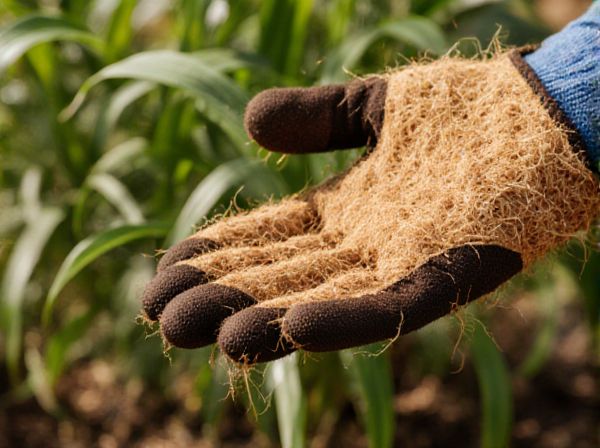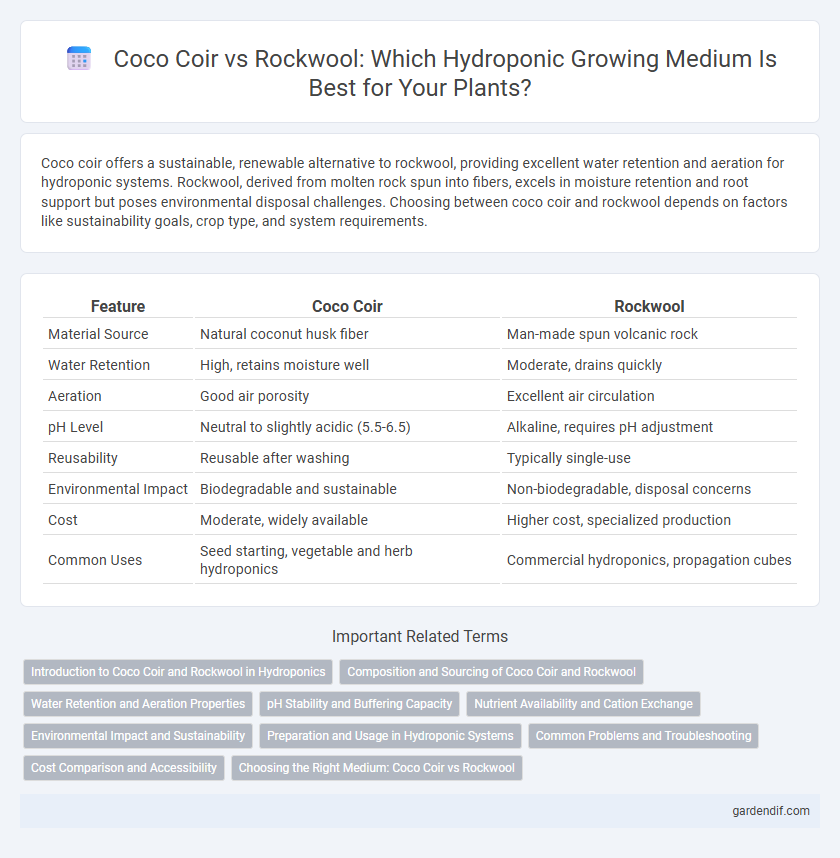
Coco Coir vs Rockwool Illustration
Coco coir offers a sustainable, renewable alternative to rockwool, providing excellent water retention and aeration for hydroponic systems. Rockwool, derived from molten rock spun into fibers, excels in moisture retention and root support but poses environmental disposal challenges. Choosing between coco coir and rockwool depends on factors like sustainability goals, crop type, and system requirements.
Table of Comparison
| Feature | Coco Coir | Rockwool |
|---|---|---|
| Material Source | Natural coconut husk fiber | Man-made spun volcanic rock |
| Water Retention | High, retains moisture well | Moderate, drains quickly |
| Aeration | Good air porosity | Excellent air circulation |
| pH Level | Neutral to slightly acidic (5.5-6.5) | Alkaline, requires pH adjustment |
| Reusability | Reusable after washing | Typically single-use |
| Environmental Impact | Biodegradable and sustainable | Non-biodegradable, disposal concerns |
| Cost | Moderate, widely available | Higher cost, specialized production |
| Common Uses | Seed starting, vegetable and herb hydroponics | Commercial hydroponics, propagation cubes |
Introduction to Coco Coir and Rockwool in Hydroponics
Coco coir, derived from coconut husks, offers excellent water retention, aeration, and natural antifungal properties, making it a popular organic growing medium in hydroponics. Rockwool, an inert mineral fiber made from molten basalt rock, provides superior water-holding capacity and root support, widely used in commercial hydroponic systems. Both mediums enable efficient nutrient delivery and oxygen availability, critical for healthy plant growth in soilless cultivation.
Composition and Sourcing of Coco Coir and Rockwool
Coco coir is a natural growing medium derived from the fibrous husks of coconut shells, sourced primarily from tropical regions where coconuts are abundant. Rockwool, also known as stone wool, is an inorganic substrate made by melting basalt rock and chalk at high temperatures before spinning into fibers, with production centralized in industrial facilities. The renewable nature of coco coir contrasts with the synthetic origins of rockwool, influencing sustainability and environmental impact in hydroponic cultivation.
Water Retention and Aeration Properties
Coco coir offers excellent water retention due to its high porosity, allowing roots to access moisture consistently while maintaining adequate aeration. Rockwool provides superior aeration with its fibrous structure, promoting oxygen availability to roots but tends to hold less water compared to coco coir. Both media balance water retention and aeration differently, impacting nutrient uptake and root health in hydroponic systems.
pH Stability and Buffering Capacity
Coco coir offers a more stable pH range, typically between 5.5 and 6.8, which suits a wide variety of hydroponic crops and requires less frequent pH adjustments. Rockwool tends to have a higher initial pH, often above 7.0, necessitating pre-treatment to stabilize pH levels before use. The buffering capacity of coco coir is superior due to its natural organic compounds, enabling it to maintain nutrient availability and reduce pH fluctuations compared to the inert nature of rockwool.
Nutrient Availability and Cation Exchange
Coco coir offers superior cation exchange capacity compared to rockwool, enhancing nutrient availability by effectively retaining and releasing essential cations like potassium, calcium, and magnesium to plant roots. Rockwool, though inert and sterile, lacks natural buffering properties, requiring more frequent nutrient solution adjustments to maintain optimal ion balance. The enhanced nutrient retention and exchange in coco coir leads to more stable root zone conditions, promoting healthier plant growth and higher yields in hydroponic systems.
Environmental Impact and Sustainability
Coco coir, derived from coconut husks, is a renewable and biodegradable growing medium with low environmental impact, as it repurposes an agricultural byproduct and decomposes naturally. In contrast, rockwool is made from spun volcanic rock, requiring high energy consumption for production and generating non-biodegradable waste that persists in landfills. Choosing coco coir supports sustainable hydroponic practices by reducing carbon footprint and promoting circular agriculture, while rockwool's environmental costs present challenges for eco-friendly cultivation.
Preparation and Usage in Hydroponic Systems
Coco coir requires thorough soaking and buffering to remove excess salts and achieve optimal pH for nutrient uptake, making it ready for various hydroponic systems like drip emitters and flood tables. Rockwool demands pre-soaking in pH-adjusted water to stabilize its alkaline properties and enhance water retention, especially suitable for propagation and hydroponic NFT systems. Both substrates offer excellent aeration and moisture retention, but preparation significantly impacts nutrient availability and root health in hydroponic cultivation.
Common Problems and Troubleshooting
Coco coir often faces issues with nutrient lockout due to its high cation-exchange capacity, requiring careful pH and nutrient management to prevent deficiencies. Rockwool tends to retain excess moisture, leading to root rot and fungal infections if drainage or aeration is inadequate. To troubleshoot, flushing coco coir with balanced nutrient solutions can resolve salt buildup, while improving airflow and ensuring proper drainage mitigates Rockwool's moisture-related problems.
Cost Comparison and Accessibility
Coco coir generally costs less than rockwool and is widely available in garden centers and online, making it a more accessible option for hydroponic growers. Rockwool, while efficient for water retention and aeration, often comes at a higher price and may require specific suppliers, limiting its accessibility for beginners or small-scale growers. The choice between coco coir and rockwool depends on budget constraints and local availability, with coco coir offering a budget-friendly and readily obtainable solution.
Choosing the Right Medium: Coco Coir vs Rockwool
Coco coir offers superior water retention and aeration, making it ideal for fast-growing plants in hydroponic systems, while rockwool provides excellent root support and drainage, favored for seedlings and clones. Both mediums are pH neutral but require careful monitoring; coco coir may need buffering due to high potassium levels, whereas rockwool can impact solution pH stability. Selecting between coco coir and rockwool depends on crop type, water quality, and nutrient management preferences, ensuring optimal root health and yield.
Coco Coir vs Rockwool Infographic

 gardendif.com
gardendif.com